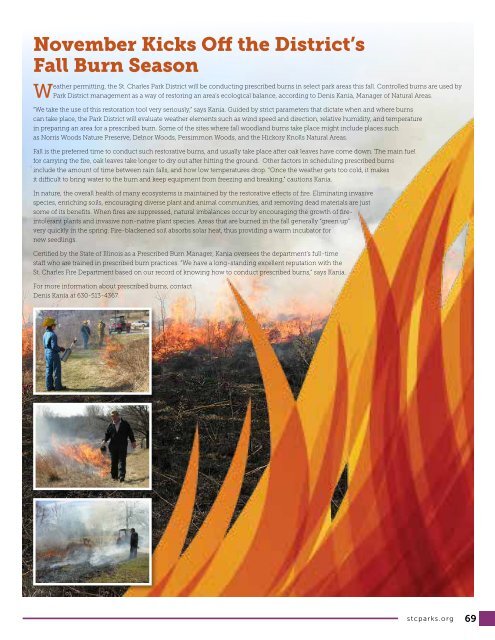Park District
Create successful ePaper yourself
Turn your PDF publications into a flip-book with our unique Google optimized e-Paper software.
November Kicks Off the <strong>District</strong>’s<br />
Fall Burn Season<br />
Weather permitting, the St. Charles <strong>Park</strong> <strong>District</strong> will be conducting prescribed burns in select park areas this fall. Controlled burns are used by<br />
<strong>Park</strong> <strong>District</strong> management as a way of restoring an area’s ecological balance, according to Denis Kania, Manager of Natural Areas.<br />
“We take the use of this restoration tool very seriously,” says Kania. Guided by strict parameters that dictate when and where burns<br />
can take place, the <strong>Park</strong> <strong>District</strong> will evaluate weather elements such as wind speed and direction, relative humidity, and temperature<br />
in preparing an area for a prescribed burn. Some of the sites where fall woodland burns take place might include places such<br />
as Norris Woods Nature Preserve, Delnor Woods, Persimmon Woods, and the Hickory Knolls Natural Areas.<br />
Fall is the preferred time to conduct such restorative burns, and usually take place after oak leaves have come down. The main fuel<br />
for carrying the fire, oak leaves take longer to dry out after hitting the ground. Other factors in scheduling prescribed burns<br />
include the amount of time between rain falls, and how low temperatures drop. “Once the weather gets too cold, it makes<br />
it difficult to bring water to the burn and keep equipment from freezing and breaking,” cautions Kania.<br />
In nature, the overall health of many ecosystems is maintained by the restorative effects of fire. Eliminating invasive<br />
species, enriching soils, encouraging diverse plant and animal communities, and removing dead materials are just<br />
some of its benefits. When fires are suppressed, natural imbalances occur by encouraging the growth of fireintolerant<br />
plants and invasive non-native plant species. Areas that are burned in the fall generally “green up”<br />
very quickly in the spring. Fire-blackened soil absorbs solar heat, thus providing a warm incubator for<br />
new seedlings.<br />
Certified by the State of Illinois as a Prescribed Burn Manager, Kania oversees the department’s full-time<br />
staff who are trained in prescribed burn practices. “We have a long-standing excellent reputation with the<br />
St. Charles Fire Department based on our record of knowing how to conduct prescribed burns,” says Kania.<br />
For more information about prescribed burns, contact<br />
Denis Kania at 630-513-4367.<br />
stcparks.org<br />
69


